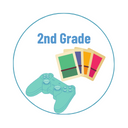Maths Frame: Enhancing Learning and Creativity
In the realm of education, innovation is the key to nurturing young minds. One such innovation that has been making waves in the educational landscape is the concept of "maths frames." In this article, we will delve into the world of maths frames, exploring what they are, how they work, and the myriad benefits they offer to students. So, let's embark on this educational journey and unlock the potential of maths frames.
What Are Maths Frames?
Maths frames, in essence, are versatile tools designed to facilitate mathematical learning among students. These frames come in various forms, from physical manipulatives to digital applications, and they are designed to cater to learners of all ages. At their core, maths frames provide a visual representation of mathematical concepts, making abstract ideas more tangible and accessible.
. Continue Below >>
Multiplication Games | Addition Games| Subtraction Games | Telling Time Games | Fraction Games |
Kindergarten Math Games

Play free preschool and kindergarten math games for kids. Fun math activities for kindergarten
Go to page1st Grade Math Games

Math games for 1st grade students to play games and practice different math topics. Maths games for class 1
Go to page2nd Grade Math Games

2nd grade math games for kids to play and practice math problems. Maths games for 2nd class
Go to page3rd Grade Math Games

3rd grade math games for kids to play and practice math problems. Maths games for class 3
Go to page4th Grade Math Games

4th grade math games for kids to play and practice math problems. Fun math activities for 4th graders
Go to page5th Grade Math Games

5th grade math games for kids to play and practice math problems. Cool math games for 5th graders
Go to page6th Grade Math Games

6th grade math games for kids to play and practice math problems. Math jeopardy 6th grade.
Go to page7th Grade Math Games

7th grade math games for kids to play and practice math problems. Math games for grade 7
Go to page
The Types of Maths Frames
-
Physical Maths Frames: These are tangible, hands-on tools that students can touch and manipulate. They often consist of materials like wooden blocks, beads, and wires, allowing learners to physically construct mathematical models.
-
Digital Maths Frames: With the advancement of technology, digital maths frames have gained popularity. These are software applications or online platforms that simulate physical frames, offering a virtual environment for mathematical exploration.
How Do Maths Frames Work?
Getting Started
Before we dive into the intricacies of maths frames, it's important to understand how to use them effectively. Here's a basic step-by-step guide:
Step 1: Select a Mathematical Concept: Identify the specific mathematical concept you want to explore, such as addition, subtraction, multiplication, or division.
Step 2: Choose Your Frame: Depending on your preference and availability, select either a physical or digital maths frame.
Step 3: Manipulate the Frame: Begin by manipulating the materials or digital tools to represent the chosen mathematical concept visually.
Step 4: Explore and Learn: Experiment with the frame, create patterns, and solve problems to gain a deeper understanding of the mathematical concept.
Benefits of Maths Frames
Now that we understand the basics, let's explore the incredible benefits of incorporating maths frames into the learning process.
1. Enhanced Comprehension
Maths frames transform abstract mathematical concepts into concrete, visual models. This visual representation enhances comprehension, particularly among visual learners, by providing a clear, hands-on experience.
2. Improved Problem-Solving Skills
Engaging with maths frames encourages critical thinking and problem-solving. Students are prompted to analyze patterns, make connections, and develop strategies to solve mathematical problems.
3. Fostering Creativity
Maths frames allow for creative exploration. Students can experiment with different approaches to solve problems, fostering a sense of curiosity and innovation in their mathematical journey.
4. Inclusivity
These tools cater to diverse learning styles. Whether a student is a visual, auditory, or kinesthetic learner, maths frames provide a versatile learning experience that accommodates various preferences.
5. Long-term Retention
The hands-on nature of maths frames promotes long-term retention of mathematical concepts. When students actively engage with these tools, they are more likely to remember and apply what they have learned.
Integrating Maths Frames into Education
Educators play a pivotal role in harnessing the potential of maths frames. By incorporating these tools into their teaching methods, they can create a dynamic and interactive learning environment. Here are some strategies for educators:
1. Curriculum Integration
Integrate maths frames into the curriculum, aligning them with specific learning objectives. This ensures that students encounter these tools regularly in their studies.
2. Collaborative Learning
Encourage group activities where students work together with maths frames. Collaborative learning enhances peer-to-peer teaching and fosters teamwork.
3. Assessments
Incorporate maths frame-based assessments to evaluate students' understanding of mathematical concepts. These assessments can be both formative and summative, providing valuable feedback.
Conclusion
In the ever-evolving landscape of education, maths frames stand as a testament to innovation and creativity. They bridge the gap between abstract mathematics and real-world applications, making learning an exciting and engaging journey. As educators, parents, and students alike embrace the power of maths frames, we pave the way for a brighter, mathematically proficient future.
FAQs
1. Are maths frames suitable for all age groups? Yes, maths frames can be adapted to suit learners of all ages, from young children to adults seeking to enhance their mathematical skills.
2. Can digital maths frames replace physical ones entirely? Digital maths frames offer convenience, but physical frames provide a tactile experience that some learners find invaluable. Both have their merits and can be used in tandem.
3. Are there any recommended resources for finding maths frame activities? Numerous educational websites and apps offer a wide range of maths frame activities and resources. Some popular options include Khan Academy and Mathletics.
4. How can parents support their children in using maths frames at home? Parents can engage in math activities with their children, explore online resources, and encourage mathematical discussions to reinforce learning.
5. Do maths frames align with educational standards? Yes, many educational institutions and curriculum frameworks integrate maths frames as effective tools for teaching and learning mathematics.











